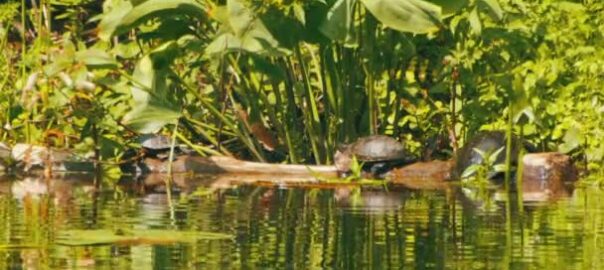My big dream
Since years with my turtle-lover friends we are considering the idea to build a shelter for unwanted pet turtles. The majority of exotic turtles are counted to the invasive species in my country, e. g. red-eared or yellow-eared sliders, gliders, snapping turtles, and so on.

cute red-eared slider hatchling
Lovely baby turtles are bought by adults for their kids. Alas, as the animal grows in size, they mean more ‘problem’: they need expert care, bigger enclosure, aquaterrarium with special lighting and water filters, fresh-water fishes for food, etc. Also, turtles aren’t ideal pets for children: they don’t cuddle and don’t enjoy being handled. This is why hundreds or even thousands of pet turtles end up discarded. They get thrown into rivers, lakes or ponds. Despite of the common belief, these places are far from being ideal for these creatures. They are likely to starve, to freeze, or to die because of weakness, illness, or a predatory attack. Those who survive are serious threat to local wild fauna.

Aranka, one of my turtle ladies, her right front paw missing
Red-eared and yellow-eared sliders are famous invasive species, massively built, made-to-survive animals. In my country, placing them into the nature is a crime. However, no serious sanctions are applied against careless owners… We all see that the problem exists, but no solution comes from the state, and the most of the conservationist organizations are rather short on funds. So, it’s up to us, turtle-lovers to do something.

grown-up red-eared slider (photo by John White, Maryland DNR)
As I see there are two major tasks:
- create sanctuaries where these pets find a safe home, without endangering local wildlife
- lobby for the ban of exotic pet trade as it is (including inland breeding of potentially invasive species)
Action plan
I think the best would be to establish a foundation first to co-ordinate the purchase of territory, to supervise the construction work and manage the maintenance issues. The sanctuary needs at least a territory of 3 square kilometre (250 acres). This would be enough to install a buffer zone – this way no polluted soil, harmful substances or poisonous plants would infest the habitats. For the start 10 ponds would be created: 1 as a quartantine, the others for permanent living. Water cleaning is crucial, filters and pumps would be installed and monthly checked. The connected ponds would be equipped with reed and multiple aquatic plants. The place could accommodate about two thousand turtles at least.
Potentially invasive species that would be adopted to save natural waters:
- Red-eared slider (Trachemys scripta elegans)
- Yellow-eared slider (Trachemys scripta scripta)
- River cooter (Pseudemys concinna heiroglyphica)
- False map turtle (Graptemys pseudogeographica)
- Balkan pond turtle (Mauremys rivulata)
- Chinese softshell turtle (Pelodiscus sinensis)
- Snapping turtle (Chelydra serpentina)
- Western painted turtle (Chrysemys picta belli)
Also, a complex building (powered by green energy) would be erected where winter lodging would be possible – and at the ground floor the animals could walk in or out at their leisure to reach underground ponds and hiding areas. In the upper side of the building we’d create a vet station, and a hall and some rooms, for classes or conference (without disturbing the animals). Plus there would be a studio for living. 🙂

Above is the first plan, but later the ponds part was extended. There would be a part where multiple ponds will be connected with bridges and tunnels, and a bigger pond, plus a separate one for smaller turtles. Below is the sketch (the flower part is where agricultural cultivation would start):

Everything would be designed with the comfort of the turtles in mind. There are questions about making a sort of roofs for smaller ponds, to defend the animals from bird attacks. The fences would have to be also thoughtfully constructed, to prevent escaping. Every animal would get a microchip for identification. Monitoring and ethological research would be possible with underwater cameras. Laid eggs would be collected from special sandy areas, preventing hatching.
There are three main possible options to obtain the costs of maintenance: agricultural usage of the remaining territory (rapeseed or lavender culture), donations and tenders. The foundation would take care of the sanctuary’s safe operation.

Also, as the institution works finely, with time we may build an additional place for helping to save the local turtle, the pond terrapin (Emys orbicularis) with an incubation program. Expert help is already available (and has been offered) from conservationists and animal welfare activists.
To create this wonderful place, all help or advice is accepted! 🙂
Starting cost: 200.000 EUR
